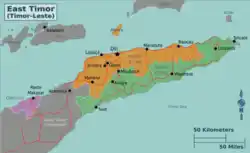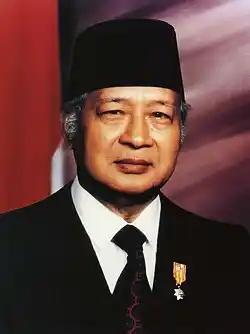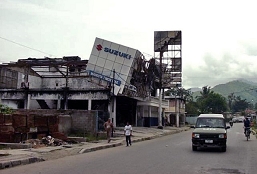
The Indonesian occupation of East Timor was a military occupation of the eastern half of the island of Timor in the East Indies by Indonesia which began in December 1975. It lasted for quarter of a century, only coming to an end following an independence vote in 1999 and a phased withdrawal through to 2002. The occupation came about after Portuguese colonial rule collapsed in East Timor following the Carnation Revolution in Portugal in 1974. Indonesia controlled the western half of Timor and moved to claim the whole island late in 1975. The occupation forces and government were guilty of widespread crimes over the years and an extremely repressive political rule. Although the Indonesia government was supported in its actions by many leading nations, the occupation grew more and more condemnation over time as a result of atrocities like the Santa Cruz massacre of 1991. Eventually a peace process led to the independence of East Timor as Timor-Leste. The occupation led to the flight of several thousand people from East Timor over a period of two and a half decades, while the independence vote in 1999 precipitated a mass exodus of quarter of a million people.[1]
Research your ancestors on MyHeritage
Indonesian occupation of East Timor chronology of eventsIndonesian occupation of East Timor chronology of events

The island of Timor was being visited by the European colonial powers as early as the middle of the sixteenth century. At this stage Portugal was the main colonial power in the East Indies. In the seventeenth century it began establishing more permanent trading stations on the coast of the island, though it was not until the eighteenth century that bigger settlements were founded. In part this was because the Portuguese position as the colonial power here had been completely undermined by the Dutch. While the Dutch acquired control of the vast majority of the islands, the Portuguese concentrated on Timor, one of their few remaining enclaves. Even on this island they could not maintain full control and the Dutch moved in to occupy the western half. It was because of these developments that when Indonesia emerged in the aftermath of the Second World War as a country comprised of the former Dutch colonies in the East Indies, the eastern side of Timor was not part of that new nation.[2]
Unlike all of the other colonial power, Portugal doggedly refused to decolonize after the Second World War, retaining control over the Cape Verde Islands, Angola and Mozambique in Africa, Macau in southern China and the eastern half of Timor in the East Indies. The end of their colonial empire, when it came, was quite sudden. In occurred as a result of the Carnation Revolution in Portugal in April 1974, which overthrew the dictatorial Estado Novo government. The interim government quickly decided to cease sending extensive military resources to the colonies to try and maintain control over them. Hence, when a civil conflict broke out in the Portuguese colony on Timor, it quickly resulted in the emergence of an independent nation in 1975.[3]
The Indonesian government of the authoritarian ruler, Suharto, watched these developments closely. As the power which controlled the western half of Timor and the dominant power of the East Indies, Indonesia viewed eastern Timor as rightly being a part of its country. Thus, in December 1975 the Indonesian government invaded and occupied East Timor. It annexed the territory as its 27th province the following year.[4] This commenced an occupation that would last down to the end of the twentieth century. It was extremely repressive, with mass atrocities, illegal detainment, torture and murder used to control East Timor, leading to an estimated 200,000 deaths over a 24-year period, though the exact death toll remains unclear.[5]
The occupation was also fiercely resisted by the Revolutionary Front for an Independent East Timor or Fretilin. This group had formed in 1974 to initially oust the Portuguese from the country, though they are more often associated with resistance to Indonesia. Over more than two decades they engaged in a guerilla war against the occupation forces. They were largely destroyed in the late 1970s by the occupation government, but survived and revitalized the independence movement in the 1990s.[6]
With the end of the Cold War the rationale for supporting a continued occupation of East Timor for countries like the United States and Australia was nullified and pressure was applied on Indonesia to relinquish control over the eastern half of the island. A referendum asking the people of East Timor if they wished to remain as part of Indonesia on the 30th of August 1999 was rejected by 78% of voters and the occupation was gradually wound down. East Timor achieved full independence in 2002 as the Democratic-Republic of Timor-Leste.[7]
Extent of migration from East TimorExtent of migration from East Timor

The occupation of East Timor led to a certain amount of migration from that side of the island, both in the immediate period of the initial occupation in late 1975 and 1976 and in the years that followed, though as a poor island nation surrounded by other Indonesia territory there was little room for a major refugee crisis to develop. Of the thousands who did leave, many found their way to places like Malaysia and Australia. The larger refugee crisis actually occurred at the end of the occupation when approximately a quarter of a million people fled from East Timor to the western half of the island. These were primarily people who had supported the Indonesian occupation over many years. Their decision to leave was driven by a wave of vigilante violence against perceived occupation collaborators in the aftermath of the independence referendum. This flight was largely transient and as the political process resolved itself in a peaceful manner in the early 2000s the vast majority of these migrants returned to East Timor.[8]
Demographic impact of the Indonesian occupationDemographic impact of the Indonesian occupation
The demographic impact of the Indonesian occupation of East Timor lay primarily in the loss of life inflicted by the Indonesian government. The occupation forces engaged in mass detainment, extra-judicial executions and massacres over many years, while famine conditions and disease proliferated. There is no consensus as to the exact death toll and studies have varied from a lower level of 80,000 to upwards of 300,000, with a median figure of between 150,000 and 200,000 being most probable. This constituted somewhere between 20% and 25% of the population as it stood when the occupation began in December 1975. Because of this, many international rights groups and bodies have termed the Indonesian occupation to constitute an attempted genocide.[9]
See alsoSee also
Explore more about the Indonesian occupation of East TimorExplore more about the Indonesian occupation of East Timor
- East Timor Country Profile at BBC News
- Timor-Leste (East Timor) at The Center for Justice and Accountability
- East Timor Revisited at The National Security Archive
References
- ↑ https://thenonviolenceproject.wisc.edu/2022/04/21/from-pandemonium-to-peace-east-timors-struggle-for-self-determination/
- ↑ Teresa Almeida Cravo and Maria Raquel Freire, ‘Portugal and East Timor’, in European Review of International Studies, Vol. 1, No. 3 (Winter, 2014), pp. 39–59.
- ↑ https://www.theguardian.com/world/2019/aug/30/east-timor-indonesias-invasion-and-the-long-road-to-independence
- ↑ https://www.bbc.co.uk/news/world-asia-pacific-14952883
- ↑ https://hmh.org/education/east-timor-1975-1999/
- ↑ https://www.bbc.co.uk/news/world-asia-pacific-14952883
- ↑ https://www.refworld.org/reference/annualreport/freehou/1999/en/53667
- ↑ https://www.unhcr.org/us/news/east-timorese-refugee-saga-comes-end
- ↑ https://hmh.org/education/east-timor-1975-1999/

